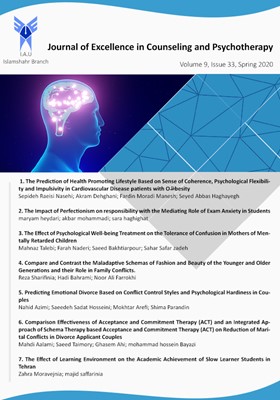-
-
List of Articles
-
Open Access Article
1 - The Prediction of Health Promoting Lifestyle Based on Sense of Coherence, Psychological Flexibility and Impulsivity in Cardiovascular Disease patients with Obesity
Sepideh Raeisi Nasehi Akram Dehghani Fardin Moradi Manesh Seyed Abbas Haghayegh -
Open Access Article
2 - The Impact of Perfectionism on responsibility with the Mediating Role of Exam Anxiety in Students
maryam heydari akbar mohammadi sara haghighat -
Open Access Article
3 - The Effect of Psychological Well-being Treatment on the Tolerance of Confusion in Mothers of Mentally Retarded Children
Mahnaz Talebi Farah Naderi Saeed Bakhtiarpour Sahar Safar zadeh -
Open Access Article
4 - Compare and Contrast the Maladaptive Schemas of Fashion and Beauty of the Younger and Older Generations and their Role in Family Conflicts.
Reza Sharifinia Hadi Bahrami Noor Ali Farrokhi -
Open Access Article
5 - Predicting Emotional Divorce Based on Conflict Control Styles and Psychological Hardiness in Couples
Nahid Azimi Saeedeh Sadat Hosseini Mokhtar Arefi Shima Parandin -
Open Access Article
6 - Comparison Effectiveness of Acceptance and Commitment Therapy (ACT) and an Integrated Approach of Schema Therapy based Acceptance and Commitment Therapy (ACT) on Reduction of Marital Conflicts in Divorce Applicant Couples
Mahdi Aalami Saeed Taimory Ghasem Ahi mohammad hossein Bayazi -
Open Access Article
7 - The Effect of Learning Environment on the Academic Achievement of Slow Learner Students in Tehran
Zahra Moravejnia majid saffarinia
-
The rights to this website are owned by the Raimag Press Management System.
Copyright © 2021-2025







